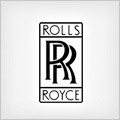
ROLLS-ROYCE Phantom
Generations Timeline, Specs and Pictures

The eighth generation Rolls-Royce Phantom was introduced in 2017 to set a new benchmark in the global luxury industry.
The engineers have built the new Phantom from the ground up to be scalable to the size and weight requirements of different future Rolls-Royce models, including those with alternative propulsion, traction and control systems, and more. The chassis of the Phantom VIII is 30 percent more rigid and significantly lighter than the outgoing version. The air suspension is all-new taking the Magic Carpet Ride to a new level while the acoustic insulation has been improved for almost total isolation from the exterior. The heart of the luxurious behemoth is a redeveloped V12 engine which has been tuned to deliver more torque at lower revs to ensure more silence. Another benchmark, the Electronic Architecture of the New Phantom is the largest ever component produced by the BMW Group, let alone Rolls-Royce, helping to make New Phantom the most technologically advanced Rolls-Royce ever.
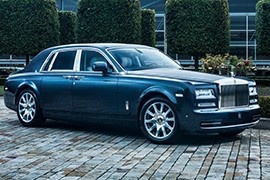
Opulent, grandiose and impressively powerful, 3 words to sum up the 2012 Phantom.
As you would expect, the ultra-luxurious Phantom’s cabin was fitted with the finest leather, wood trim and metal trim, plus sheepskin carpets and even hidden Rolls Royce badged umbrellas for rainy days.
Other distinctive features included an optional fiber-optic headliner designed to create the illusion of a starry night, cabin privacy curtains and a trunk-mounted wine cooler.
While the regular Phantom offered great interior room with impressive legroom and headroom for the rear passengers, Rolls Royce also offered the Extended Wheelbase version that added 10-inches rear-seat legroom.
Standard equipment included 21-inch alloy wheels, adjustable air suspension, power-closing rear coach doors, a power trunk lid, soft-close power front doors, a sunroof, automatic climate control, heated front and rear seats and even picnic tables for the rear passengers.
Also standard was a Bluetooth connectivity, a navigation system, a 15-speaker Lexicon audio system and voice control.
As if the extensive list of standard features was did not provide enough luxury, the Phantom could be heavily personalised by choosing the desired exterior color for an additional cost.
Standard safety features included antilock brakes, traction control and stability control, as well as side airbags and full-length side curtain airbags.
The 6.7-liter V12 engine produced 452 hp and took only 5.7 seconds in the sprint to 100 kph. There’s no reason to discuss the fuel consumption, as nobody would have bought a Phantom for fuel-economy reasons.
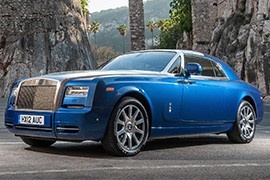
Rolls-Royce designed the Phantom Coupe to be driven by its owner, not by some hired chaffeur, and it succeeded.
Under BMW management, Rolls-Royce brand raised again, and the Spirit of Ecstasy shined proud on the Pantheon grille. The Coupe version of the Phantom was the most impressive personal luxury vehicle from its times. It was designed from scratch, built on an aluminum space-frame, and powered by a state-of-the-art engine.
Rolls-Royce is the most luxurious brand in the world, and it was the same in 2012 when the British brand introduced the Phantom Coupe. It was a new era for the famous carmaker, and with the technological help from the German carmaker, it succeeded to become great again. The big luxurious barge was designed to impress. Its massive size, flat and vertical front end, and low-roof stance were just a few elements that made the Phantom Coupe looks mean on the road. Its small headlights next to the massive silver grille didn’t look out of place.
With its rear-hinged doors (suicide-type), the Phantom Coupe offered very easy access inside the luxurious cabin. It was a four-passenger vehicle, but it was mainly built for those at the front. Except for a few buttons, there was no plastic inside. A Rolls-Royce should have only leather, wood, and metallic interior elements. An infotainment display carried-over from the BMW 7-Series was installed on the dash panel, above the center stack.
The technology under the bodywork was another masterpiece, from the 6.75 V12 engine to the drivetrain and the suspension that could cancel the noise and offer a great comfort level.

The 2006 Drophead Coupe is the newest convertible model launched by the British car manufacturer which is entirely based on the Phantom model unveiled in 2003.
The Drophead Coupe was presented at the 2007 edition of the North American International Auto Show which was held in Detroit, Michigan in January, 2007. Although it is based on the 2003 Phantom, the Drophead Coupe’s design was also inspired by the 100EX car concept which debuted in 2004. To continued Rolls Royce’s tradition, the car had a 6.75 V12 engine that produced 460 horsepower and a maximum speed of 149 km/h.

With many great coupes launched under the Rolls Royce brand, it was time to add a new member to the Phantom family, the Coupe version.
While the coupe was not a sports car, it was still a sportier version with different dampers, a different roll bar and a more precise steering. The Rolls Royce CEO talked about the coupe saying it was more of a driver’s car.
The Coupe offered seating for 4 in great luxury, with great headroom and legroom for everyone.
The exterior design was inspired by the older coupes of the past, and the sloping roof was chosen from more than 3 variants proposed at the time, demonstrating the great attention given to every detail.
The coupe had a higher top speed, but it was still luxurious and comfortable.
The hinged doors added to the car’s attractive design and getting inside the cabin was a real pleasure. The controls were intuitively placed and were easy to reach while driving.
The attention to details was easily noticeable inside the cabin as well, with elegant touches added to the dashboard, such as an elegant dash clock.
Excepting for the saloon, the Coupe was one of the quietest cars available due to the extraordinary refinement levels.
Despite the heavy body for a Coupe, the luxurious vehicle reached 100 kph in around 5.6 seconds. The 6749 cc V12 engine developed 453 hp and was mated with a 6-speed manual transmission, the power being sent to the rear wheels.

With an imposing look and presence, the Rolls Royce Phantom was the choice of the buyers looking for exclusivity and opulence.
An ultra-premium luxury sedan, the Phantom was sold for a huge price compared to other luxurious sedans on the market, such as the BMW 7-Series or the Mercedes S-Class.
Easily recognisable as a Rolls Royce, BMW highly contributed to the Phantom’s engineering, while the model was equipped with the latest technologies available.
The Phantom was available in the base version or the EWB - the extended wheelbase model. Opting for the EWB was like adding another luxurious vehicle to your fleet, but value didn’t seem to be a point of interest for the buyers of such a model.
Most of the luxurious features came standard, such as 21-inch aluminum wheels, adjustable air suspension, bi-xenon headlights, LED running lights, soft-close power front doors, a sunroof, front and rear parking assist, heated seats, picnic tables, bluetooth, a navigation system, a premium 15-speaker sound system, voice controls and keyless go.
The interior was fitted with a leather headliner with wool and cashmere accents.
Besides the numerous standard leather and wood trim options, customers could choose their preferred color for the leather upholstery for an additional fee.
Other optionals included different alloys, a front and rear camera system, a rear center console, a drinks cabinet, the “Starlight Headliner”, rear curtains, 12-inch monitors in the back, a trunk-mounted wine cooler and others.
Due to the enormous dimensions, the Phantom was not the most pleasant car to drive around town, as handling was not top priority for such a luxurious and opulent sedan.
The ride quality however was flawless. Bumps, potholes - you name it - and the passengers could continue their nap as if it never happened.

Drawing inspiration from the company’s heritage, the Rolls Royce Phantom unveiled in 2003 was the first model produced under BMW’s ownership.
In 2005, Rolls added to their range a longer Phantom named Phantom EWB - extended wheelbase. The increased wheelbase added 250mm to the rear cabin, offering the rear passengers more space and comfort, without compromising handling and agility.
To build the EWB, Rolls only needed to design a new aluminum roof and back door panels.
The design and the engineering team spent four years to develop the Phantom, and the result was a vehicle that was easily recognisable as a Rolls-Royce from any angle, retaining the traditional design cues.
The Rolls Royce factory located in Goodwood, West Sussex, used only 3 robots to produce the Phantom, while the final assembly was done by hand, including the body, the paint, the wood and the leather work, according to the customer’s individual specification.
Hand-assembled by the Rolls-Royce technicians, the heart of the new Phantom was a naturally aspirated 6.75-liter V12 engine. The unit was mated with a 6-speed automatic transmission and developed a massive 720 pound-feet of torque, with the luxurious Phantom reaching 100 kph in around 5.7 seconds.
Inside, simplicity defined the Phantom’s interior. The rarely used controls were kept out of sight and even the multimedia screen was hidden behind a revolving panel placed in the center of the dashboard. The most advanced technology available was combined with traditional hand-craftmanship, offering an unique and luxurious feel.
The rear cabin was equipped with picnic tables and 12-inch monitors linked to a six-DVD changer, besides allowing to view digital television.
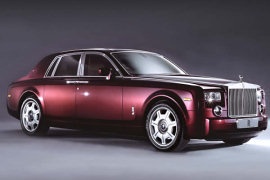
Drawing inspiration from the company’s heritage, the Rolls Royce Phantom unveiled in 2003 was the first model produced under BMW’s ownership.
The design and the engineering team spent four years to develop the new Phantom, and the result was a vehicle that was easily recognisable as a Rolls-Royce from any angle.
Retaining the traditional design cues, the 2003 Phantom was built on a unique platform, with a body made mostly of aluminum.
The Rolls Royce factory located in Goodwood, West Sussex, used only 3 robots to produce the Phantom, while the final assembly was done by hand, including the body, the paint, the wood and the leather work, according to the customer’s individual specification.
Hand-assembled by the Rolls-Royce technicians, the heart of the new Phantom was a naturally aspirated 6.75-liter V12 engine. The unit was mated with a 6-speed automatic transmission and developed a massive 720 pound-feet of torque, with the luxurious Phantom reaching 100 kph in around 5.7 seconds.
Inside, simplicity defined the Phantom’s interior. The rarely used controls were kept out of sight and even the multimedia screen was hidden behind a revolving panel placed in the center of the dashboard. The most advanced technology available was combined with traditional hand-craftmanship, offering an unique and luxurious feel.
The rear cabin was equipped with picnic tables and 12-inch monitors linked to a six-DVD changer, besides allowing to view digital television.
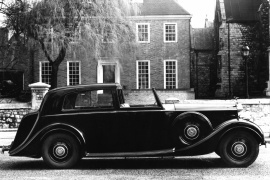
The Rolls-Royce Phantom III Sedanca de Ville was the last luxury vehicle that Henry Royce worked on and the last V-12 Rolls-Royce built until the 1998 Silver Seraph.
Built with majestic bodywork, the Phantom III Sedanca de Ville featured an exquisite bodywork built by the renowned coachbuilder Mulliner between 1936 and 1939. It showed the wealth of its owner and the power of its builder.
The Sedanca name came from Sedan and Cabriolet since the vehicle featured a closed bodywork for the rear passengers and a removable top for the driver area. The same bodywork was named De Ville by other carmakers, but Mulliner had its idea on how to name its products. With a tall and flat front radiator and the famous statue on top of it, the vehicle showed nothing more than opulence. Behind the cabin, the carmaker installed the trunk with an up-hinged lid.
Mulliner built the unusually high greenhouse so the owner could wear a tall hat while comfortably seated in the back. Inside, the coachbuilder installed a comfortable leather-wrapped bench in the back, with side armrests. As an option, the carmaker offered a wooden minibar in front of the rear seats.
Under the hood, the 7.3-liter V-12 engine was an engineering masterpiece for those times. It featured hydraulic tappets and a twin-spark ignition system (two ignition coils and 24 spark plugs). But the system proved to be less reliable, and starting with 1938, the carmaker installed regular, adjustable tappets.
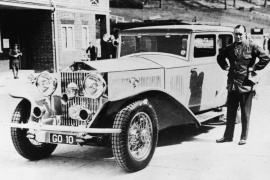
Only four years after the introduction of the Phantom I, Rolls unveiled the new Phantom I in 1929.
The previous model of Phantom, even if relatively new, it was dated. Rolls Royce had been using most of the car’s underpinnings ever since 1912. And while it was easier to go the old way, it could’ve soon become a disaster, as competition terribly increased with the models produced by Buick and Sunbeam especially.
Thus, the Phantom II was built on a completely new chassis and used an improved version of the Phantom I engine, a 7.7-liter 6-cylinder unit that developed 122 hp. The powerplant was mated with a 4-speed manual transmission.
Besides the regular version of the Phantom II that had a wheelbase of 150 inches (3,800 mm), Rolls also offered a short-wheelbase chassis with 144 inches (3,700 mm).
As most producers did at the time, Rolls Royce only offered the chassis and the mechanical parts. The vehicle’s body was the work of the coachbuilder selected by the future owner. Some of the most famous coachbuilders were Park Ward, Brewster, Mulliner, Carlton, Hooper and Henley.
In total, Rolls Royce sold 1,281 Phantom II chassises of all types.

Rolls-Royce introduced the Phantom II in 1929, and the carmaker didn’t intend to make it with a short-wheelbase, but one year later, it reconsidered that option.
Rolls-Royce Phantom II proved to be a highly successful model, and the British car manufacturer managed to sell 1,680 chassis, from which 281 were with Continental, short-wheelbase versions. Their bodyworks were built by various coachbuilders from the U.K., and the Barker&Co was the one that put a sports one, with four doors. The Phantom II Continental was the last built under the personal supervision of Henry Royce before its death in 1933.
When Rolls-Royce built the new car, it made it on a new low-slung frame with the radiator set well back. This allowed the coachbuilders to make sleeker bodyworks, and Barker took advantage and created a bodywork with a raked windshield and a short rear end. At the front, the car featured two headlights mounted on the wheel-fenders. The Phantom II was the first Rolls-Royce to sports 11 degrees tilted louvers on the engine compartment’s sides. Since the Continental was more of a driver’s car, the coachbuilder installed rear-hinged front doors to ease-up the ingress and egress and front hinged-doors in the back.
Inside, the cabin received special treatment, according to customer’s requests, but they usually went for wood and leather combination. The carmaker installed a speedometer in front of the driver post and the rest of the dials and gauges in the middle on the instrument panel. The carmaker placed the glove-box on the passenger side.
Rolls-Royce made a new engine for the Phantom II. It received a cross-flow cylinder head and counter-weights for the crankshaft. With a Barker bodywork, the car was timed with a maximum speed of 92.31 mph (148.55 kph) by an independent tester.

Rolls-Royce introduced the Phantom II in 1929 as the last of the 40/50 hp models, and it offered it with a choice of two wheelbases and a variety of bodyworks.
Like most luxurious carmakers from that era, Rolls-Royce signed a contract with exclusive coachbuilders renown for their products. In 1929, Rolls Royce appointed Park Ward to provide the bodyworks for the Phantom II. Due to the Wall Street crash of 1929 and the following years of The Depression, only 1,693 were built, and 281 were Continentals.
The short wheelbase versions of the Phantom II were named Continental since they were built for high cruising speeds on continental roads. Park Ward made a low greenhouse for the luxurious four-door sedan. It sported the same upright radiator at the front and a pair of big headlights. A third light was added as an option above the bumper. Its long and curved wheel-arches continued on the side-steps. The rear door was narrower, but that was fine; the car was built for the driver, not the rear passengers.
Inside, the customers could hand-pick the materials used, but the most often seen combination was with leather and wood. Some owners chose ivory and silk for side curtains. The dials and gauges took center stage of the dash panel. There were two individual seats at the front, while in the back, the coachbuilder installed a bench for three. Unlike the limousine, long-wheelbase versions, the Park Ward Continental II featured a shorter greenhouse. Behind the cabin, the coachbuilder installed the trunk, which was accessible only from the.
Under the hood, a 7.7-liter inline-six engine provided 120 hp. Thanks to the high gearing for the final drive, the car could sustain a higher speed for longer distances. The early models featured non-synchronous gearboxes, while the later models received a synchromesh system from the second to fourth gear.

With the Rolls Royce Silver Ghost in production for no less than 18 years, it was time for a new Phantom to be released, to replace the 40/50 model (Silver Ghost).
The 4-door luxury sedan came to life in 1925 and featured a bigger engine than its predecessor, a pushrod-OHV straight-6 unit, with 2 groups of three cylinders. Impressive for the time, even at higher speeds, the cabin was quiet enough for a conversation. And when we say speed, the Phantom I could easily reach 100 km/h.
The 7.7-liter engine produced 95 hp and the 4-door sedan could reach a maximum speed of 145 km/h.
The Phantom’s production was limited to around 3500 units.
Another major update was the replacement of the side valves with overhead valves, thus the Phantom featured a slightly higher hood.
The Phantom 1 used the same platform as the Silver Ghost, 4 wheel brakes and a servo-assistance system, however, some of the early US models were not equipped with front brakes.
Two factories handled the Phantom’s production, one in the US and one in the UK. There were a few differences between the UK and the US models, such as the wheelbases and the transmissions.
The Phantom I was replaced in 1931 when the second generation was introduced.























































